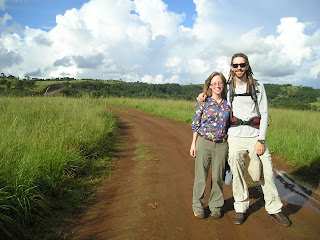Here is our second Spotlight, this time on the Kingdom of Cambodia. Our Spotlights will continue to be little snippets of things we saw and learned while in each of the countries we visit this fall. Feel free to skip the parts you don’t want to read, but don’t miss the quiz at the bottom!
 |
| Kirstie and Isaac in Mondulkiri, Cambodia (C) Isaac and Kirstie Bickford |
We only have one quick language snippet about Cambodia. The main language group and the national language is Khmer, which many of us recognize from Khmer Rouge (pronounced “Kmair Roozh”). But in Khmer, “Khmer” is not pronounced “Kmair.” You say “Kmeye” which rhymes with “eye” and, more importantly, “pie.”
Motorbikes: a Family Vehicle
Motorbikes in Cambodia are even more important than in Thailand, as fewer families can afford cars. This doesn’t prevent families from travelling together, though. We saw a group of six (three adults, three children) crammed onto one little bike. Generally, no more than three adults will ride on one motorbike. Women and monks often ride side saddle as passengers.
 |
| Loaded Motorbike in Phnom Penh, Cambodia (C) Isaac and Kirstie Bickford |
Traffic is pretty crazy in Phnom Penh. Although vehicles officially drive on the right side of the road, it is quite common to see a motorbike weaving its way through opposing traffic—horn honking often signals abnormal traffic behavior or simply means: “Look out! Comin’ through!” Crossing a street on foot is a bit like a game of Frogger – take things one lane at a time and hope people slow down or swerve around you!
Toilets
Due to popular demand, we will continue posting information about the toilets in each country we visit. Feel free to skip to the next heading if you think this is impolite conversation.
In Cambodia, the toilet situation is similar to that in Thailand. In Phnom Penh, western toilets are common. In Mondulkiri Province, we found a variety of options. Probably the most interesting was the western toilet with no seat and no tank. It was flushed “squatty style” by pouring a bucket of water into the basin. We are dubbing these “western squatties."
 |
| A western squatty in the Philippines (with a tank that was useless). Note the wastebin for TP. (C) Isaac and Kirstie Bickford |
Food
Food in Cambodia is YUMMY. They have potatoes here! Our tummies were very happy. Cambodian cuisine is not generally spicy, though you often get a tiny pepper or two beside your dish to add as desired. Beware the tiny pepper! They are scary...
 |
| Everybody's got a water buffalo! Or at least a rooster... (C) Isaac and Kirstie Bickford |
There are more buffalo and cows wandering Cambodia than Thailand; thus more beef ends up in food. Farming is especially important here. Rice, as in neighboring countries, is a staple and served at most or, in some places, all meals. See below to learn about this year’s flooding and its impact on farming.
Lofts or Stilts?
We found Cambodian architecture very interesting, as there was a very sharp divide in building types between the Khmer and the Bunong. We didn’t visit any Khmer homes, but we did see a few restaurants. In Phnom Penh they are built with loft ceilings and a straight airway from back to front. They’re basically just one big, tall room. Some owners would like to have more space in the room, so they build a loft in the back increasing floor space by about 30%, and quite effectively blocking all airflow. Try to find a table with a fan pointing on it.
 |
| Stilt home with electric blue railings. Ow ow! (C) Isaac and Kirstie Bickford |
Moving up the cost ladder, the wood frame will be walled and roofed with thatch. A little higher and people tend to either have wood walls and a thatch roof or thatch walls and a metal roof. The choice of which to improve first probably depends on the distance to a Khmer city with metal sheeting available. Most houses in the villages we visited had wood walls and thatch roofs. Bunong style houses in the city of Mondulkiri are a little fancier still, and tend to have wood or cement walls with tiled roofs. The stairways of some of these houses were very colorful!
Flooding in Cambodia
During our time in Asia, we’ve been asked about the flooding several times. So far, we have been safe from all flooding; we have the luxury of only going to dryer ground, unlike many who live here. In Thailand the flooding didn’t affect us at all as we were either in central Bangkok or in the mountains (though heavy rains prohibited our travel to some schools). At the moment, parts of Bangkok are experiencing flooding, from minor annoyance to major destruction depending on where you are. We have friends who are currently on the edge of the flood which spreads more every day.
 |
| Bu Sra Waterfall (C) Isaac and Kirstie Bickford |
Please say a prayer for those affected by the floods—that their needs will be met but also that they will have peace and not be afraid.
Quiz Time
1. What is the approximate US value of the smallest denomination riel bill?
2. What is the name of Cambodia’s most infamous leader?
3. What Wonder of the Ancient World is in Cambodia?
..Isaac and Kirstie..
Yours is fast but mine is slow!
ReplyDeleteOh, where we get them, I don't know...
ReplyDelete2. Pol Pot
ReplyDelete3. Angkor Wot
Does this count for 2/3 of a high five (since you are being so generous about it's delivery already)?
Ha ha, nice try Naomi!
ReplyDelete